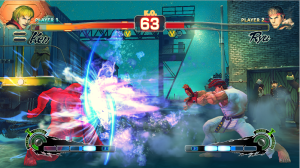One of the oldest challenges of game designers is providing the player with an adequate AI that can challenge and keep them engaged. If you make the AI too good then the player is going to get beaten into the ground, too sloppy and the player gets bored. This led to a design option called “rubber-banding” the AI that while it is popular, it is also a big example of poor game design.
Keeping Things Interesting:
Rubber-banding is commonly seen in games built around competition and where the game designers provide some kind of singleplayer option. The problem with singleplayer or specifically computer controlled opponents in competitive games is that the AI doesn’t have the ability to improvise like a human player.
This is why there is a big difference between learning to fight an AI opponent in Street Fighter and fighting someone else. What commonly ends up happening is that the player begins to run away with the match or round and the AI can’t do anything about it which leads to the “gamer getting bored” result from the start of the post.
To combat this, game developers implemented a rubber-banding AI — Meaning that the AI will shift its play style according to how well the player is doing. If the player falls behind, the AI will not play as well to let them catch up; if the player starts to win then the AI will become smarter and play better to close the gap.

strategy games like Civilization are notorious for giving the AI advantages to let them keep up with better players instead of just playing the game better.
We usually see rubber- banding AI in competitive titles where it’s easy to see who is winning at a glance and such comebacks are possible.
In racing games for instance you can easily tell who’s in what place and give them certain advantages to help boost their position.
This in fact was a major component of the design in the Mario Kart series and how the best and most damaging or race effecting items would only be given to players who were close to last place. Obviously, these items could change the scope of the race and often times would mess with the leader board.
Without items it’s easy to rubber-band the AI when need be: Have the AI make less mistakes, use longer combos or in other words: play better. I don’t know if it’s been proven, but many people said that the other cars in race games would commonly be sped up to catch up to the player if they were far enough ahead.
As a designer, the use of rubber-banding AI sounds like a good idea as it keeps skilled players from just automatically running away with the game, but this is also one of the worst forms of designer manipulation that can annoy gamers.
An Unseen Advantage:
The problem with rubber-banding is that it’s an example of the developer altering the game experience outside of the player’s control. If someone is good at the game, then why should they be punished by giving the AI advantages? Even though you want the game to remain exciting, you still need to promote the player getting better at the game as that’s the best reason to keep playing.
Another issue with rubber-banding is that it’s often used as a fix-all for games with poor AI as a way to get around having to redesign the AI or make a competent one in the first place. In the Civilization series, it’s commonly known that the AI doesn’t play the game better at the higher difficulty levels, but that it’s just given more resources and advantages to compensate.

Any game built around a competition or scoring system are perfect places where rubber-banding AI can be used.
Now there is the argument that using rubber-banding AI and these methods is useful for games aimed at younger or lesser skilled gamers — People who need that extra help and don’t want to be turned off by losing constantly.
However it’s important to point out that punishing one section of your fan base for another section is not good game design and why the solution takes work but is more rewarding.
Progress for All:
The best games have means for players of all skill levels to enjoy them without stepping on the toes of the other groups. This could mean designing levels with multiple paths like in Super Mario Galaxy, difficulty modifiers that reward higher play or simply saving the hardest stuff for achievement and completist goals.
Sonic All Stars Racing Transformed is a great example of this different philosophy compared to the Mario Kart series. The game had no rubber-banding AI whatsoever and matches were left strictly to the skill level of the player against the AI. I had matches where I just completely ran away with things and some that I won by the skin of my teeth. The point is that no outside force affected how things turned out and even the items could be given to everybody.
What the developers did however to make things challenging was change the AI’s behavior based on difficulty. On the lower settings the AI would mess up and not play as well, but at the highest they would use all the shortcuts and means at their disposal to win.
In terms of the designer or outside forces controlling content, there is one exception where gamers find it acceptable and that is the use of an AI director. The AI director is a concept that was popularized in Left for Dead during the campaign and what it did was subtly affect the difficulty of the missions based on player feedback. If the players were doing well then more enemies and less item spawns would happened. And if they were barely making it, they would find more healing items to help.

The beauty of Sonic was that there was no rubber banding; the game simply offered different skill levels a balanced challenge via the difficulty options.
It’s important to note that these features were turned off or tuned way lower when playing on the highest difficulty level so that expert players were giving the full force of the game’s difficulty.
This kind of design is seen as acceptable as the game experience is not changing enough to punish or reward players based on their skill.
Bad players would lose no matter how much help they would get and expert players would still win no matter what the game threw at them. What made it worked was that the experience was just different enough on each play to keep it fresh for those that kept playing.
Being Fair:
Outside of the game mechanics and rules, you want to leave the rest to the player and the AI without having to interfere. While losing constantly is frustrating, so is having the knowledge that the game is helping you without your consent. Again you don’t want to punish one set of your fan-base over how another plays and creating a balanced experience for all skill sets is the mark of a great game designer.


